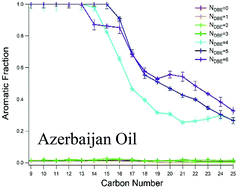Quantification of isomerically summed hydrocarbon contributions to crude oil by carbon number, double bond equivalent, and aromaticity using gas chromatography with tunable vacuum ultraviolet ionization†
Abstract
The ability to structurally characterize and isomerically quantify crude oil hydrocarbons relevant to refined fuels such as motor oil, diesel, and gasoline represents an extreme challenge for chromatographic and mass spectrometric techniques. This work incorporates two-dimensional gas chromatography coupled to a tunable vacuum ultraviolet soft photoionization source, the Chemical Dynamics Beamline 9.0.2 of the Advanced Light Source at the Lawrence Berkeley National Laboratory, with a time-of-flight mass spectrometer (GC × GC-VUV-TOF) to directly characterize and isomerically sum the contributions of aromatic and aliphatic species to hydrocarbon classes of four crude oils. When the VUV beam is tuned to 10.5 ± 0.2 eV, both aromatic and aliphatic crude oil hydrocarbons are ionized to reveal the complete chemical abundance of C9–C30 hydrocarbons. When the VUV beam is tuned to 9.0 ± 0.2 eV only aromatic hydrocarbons are ionized, allowing separation of the aliphatic and aromatic fractions of the crude oil hydrocarbon chemical classes in an efficient manner while maintaining isomeric quantification. This technique provides an effective tool to determine the isomerically summed aromatic and aliphatic hydrocarbon compositions of crude oil, providing information that goes beyond typical GC × GC separations of the most dominant hydrocarbon isomers.



 Please wait while we load your content...
Please wait while we load your content...